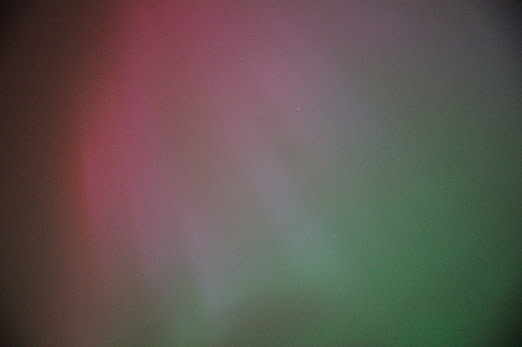On the night of the 10th/11th May we had a severe G5 geomagnetic storm which caused auroras to be seen over a wide range of earth latitudes. On the night in question I had red alerts from my AuroraWatch UK app on my phone starting about 7pm BST. Initially, the strength of the alerts were from about 300 to 500 nT at Sumburgh Head but then at 10pm BST it hit about 950 nT and I knew we were possibly going to be in for a good display (compare this with the alerts we had for the aurora on the 5th November 2023). The weather was clear at this time but there was no point in looking for the aurora until near the end of twilight (the sun set about 20:40 BST and it wasn't going to get fully dark until 23:30 BST). There was a 2 day old moon but it didn't interfere with the observations as it was very low in the north west.
I went outside to have a look at the sky about 10.30pm and I could see a band of pale light over the northern horizon, so I went in to collect my camera and tripod. The first picture I took was at 22:42 BST and this clearly showed a green arc of aurora stretching across the sky, the upper parts of which crossed the constellation of Cassiopeia. From photographs I estimated that the lower part of the arc was at a maximum height of 11 degrees above the horizon whilst the upper part was at a maximum height of 28 degrees. It stretched roughly 60 degrees either side of true north.
Here is the second picture I took at 22:42:53 BST:-
You can clearly see vertical green rays in this arc and the W of Cassiopeia near the centre of the image. In all the images I took that night I used a Nikon D90 with a Nikkor VR 18-105mm f/3.5-5.6 ED lens at 18mm. All exposures were 5s at ISO 1600 at f/3.5.
I continued to take a series of images of this arc. By 22:55 BST the location and size of the arc had already changed significantly. The maximum height of the bottom and top of the arc above the horizon had changed to 17 and 35 degrees, respectively and it stretched to 70 degrees either side of due north. I also began to see some pink rays due east at about an altitude of 36 degrees. Here is a picture of the arc at 22:58:27 BST looking north west:-
The constellation of Auriga can be seen just above the trees in the centre, whilst to the left Castor and Pollux in Gemini are above the big oak tree.
At this point in time I took a series six images about 10s apart. The rays in the arc were changing rapidly from image to image. Here is one of those images taken at 23:03:51 BST:-
You can now see that the bottom of the arc has nearly cleared the W of Cassiopeia and that the rays in the arc are well defined.
By 23:06 the top of the auroral arc had reached the zenith at its maximum and the lower part was 27 degrees above the horizon. So not only was the arc appearing to move southwards it was also swelling in extent. A few minutes later the display began to change and, unfortunately, the weather also deteriorated as well, as thin cloud began to drift in from the coast. This was perhaps the most dramatic part of the display as the auroral arc gave way to more spectacular fans of pink and red rays. This was one photographed at 23:11:25 BST:-
This view looks almost due east. To the upper right can be seen the distinctive shape of Corona Borealis. The bright star to the lower left is Vega. The colours here are very impressive ranging from red towards the lower middle of the picture to purple/pink in the upper right.
Similar patterns of pink and rays were seen in the west with the green coloration more to the north. This was the scene in this direction at 23:16:09 BST:-
Stars are just about visible but it is getting difficult to recognise constellation patterns, however, you can see the front of the "big dipper" pointing downwards at the top of this picture. Nearly four minutes later there was a nice mixture of red and green rays seen to the north:-
This was taken at 23:19:55. The front of the big dipper is again pointing downwards into the picture from the top but more to the left. The bright star halfway up the image and slightly to the right of centre is polaris. Ursa Minor extends upwards from this star.
The aurora around this time was coming and going as gaps appeared in the ever increasing cloud. Finally, we were treated to an unusual phenomenon when rays of the aurora appear from the zenith and this is called a corona:-
It is much easier to make out the shape of the big dipper to the top right of this image (taken at 23:22:41 BST). Arcturus in Bootes is the orangey bright star to the far left. Zenith at this time is roughly where the star Mizar is located (one star from the end of the handel of the big dipper). The colour of the rays above my head at this point were strongly pink/purple. Also at this time the display was so bright that it was lighting up the garden around me.
I carried on taking pictures of bits of the display until 23:48 BST but soon after this I gave up and went to bed because of the deteriorating weather.
All text and images © Duncan Hale-Sutton 2024










